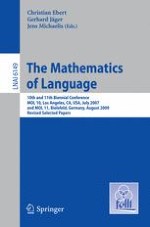2010 | Book
The Mathematics of Language
10th and 11th Biennial Conference, MOL 10, Los Angeles, CA, USA, July 28-30, 2007, and MOL 11, Bielefeld, Germany, August 20-21, 2009, Revised Selected Papers
Editors: Christian Ebert, Gerhard Jäger, Jens Michaelis
Publisher: Springer Berlin Heidelberg
Book Series : Lecture Notes in Computer Science
